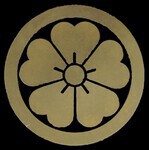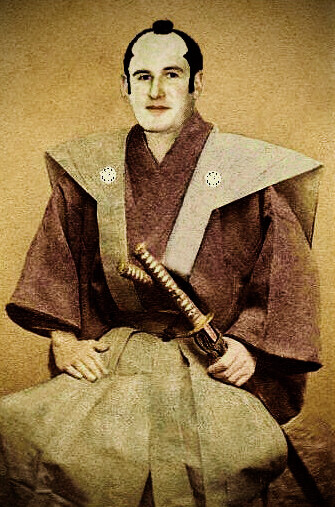-
Posts
3,242 -
Joined
-
Days Won
99
Content Type
Profiles
Forums
Events
Store
Downloads
Gallery
Everything posted by Guido
-
One of my other hobbies is brain surgery. I’m self trained, and learned most of my skills from the internet, especially the NMB (Neurosurgeon Message Board). I mean, why would people waste money on a trained professional when the pituitary gland can be removed with just a few quick cuts of the scalpel? Just make sure to use sharp knifes, and always wear a surgical mask!
-
I think John got those 4 characters correctly, and as he, I'm at a loss for the first one. The only thing I can contribute is that 國恩 (kokuon) means "gratitude from the fatherland".
-
I'm by no means knowledgeable about armor and maedate, but if I'm not totally wrong, most were made of lacquered paper, leather or wood. At least that's my impression from looking at quite a few period pieces. I've never seen any maedate made of brass that I would confidently place in the Edo period, those always seem to me like later replacements. Again, I'm not an expert, so I would like to hear from those forumites more familiar with the topic whether my observation is correct or not.
-
The maedate next to the tsuba above is not an oni, but a shikami. They are easily distinguished by their horns. Oni have square heads with small, conical, stubby horns. The shikami has the face of a shishi, and the ears and horns of an oxen.
-
Thanks a lot, Piers! I found many Kihachirō guns on Google, but almost all were in museums or on auction pages - nor real info about this smith/group, so I'm glad you provided some background on him/them. I'll post a photo of the mei when I'm back. Are there any meikans like for swords and fittings so a comparison is possible?
-
1. 落箱 (otoshibako) is the correct term. 2. I use this fabric: https://www.amazon.co.jp/gp/product/B012NCWTL0/ref=oh_aui_detailpage_o00_s00?ie=UTF8&psc=1 Btw, it's chirimen 縮緬 and hako 箱 - the "H" only becomes a "B" when it follows a vowel in a composite word.
-
I’m not a collector of Japanese matchlocks, but think everybody should have at least one . Yesterday I was offered one for a very reasonable price, and couldn’t resist: see attachment. I’ll take some more pics when I’m back from a two weeks trip I’ll go on the day after tomorrow. I have no books that cover hinawajū makers, and can’t hunt for them now because of above mentioned travels. It’s signed 摂州鶯谷喜八郎作 (Sesshū jū Uguisudani Kihachirō saku), and I wonder if anybody on this forum has info about him.
-
-
The last two years Bob had to pay out of his own pocket for those who signed up for the yakatabune, but changed their mind, and didn’t pay. Let me put it this way: I don't know who you are. I don't know what you want. I have no idea why you are behaving like that, but what I do have are a very particular set of skills. Skills I have acquired over a very long career. Skills that make me a nightmare for people like you. If you pay Bob, that'll be the end of it. I will not look for you, I will not pursue you; but if you don't, I will look for you, I will find you, and I will kill you.
-
Probably no stoners among the samurai, but you never know ... https://apjjf.org/2014/12/49/Jon-Mitchell/4231.html
-
It’s a mumei Aoe, and the name of the owner is Takahashi.
-
I only know about stipends for so called "living national treasures", they receive an annual grant of 2 million Yen, which is meant for making it easier to take in apprentices - everybody else has to scramble for himself.
-
Nah, mostly walking, just a short swim between Sakhalin and Hokkaido (45 kilometres / 28 miles). But then again, I don't know if a warm body in those cold waters will change the climate even more ....
-
I don't know if it's Chinese (could be, but then again, their inscriptions are usually real characters, just random combinations thereof), but am intrigued by the "translation". Who wrote that? Looks like something you would expect to find under Laura Palmer's fingernail ...
-
-
It's not jibberish, but a "modern" Japanese name: 川野 (Kawano, family name) 正男 (Masao, given name). Which, however, doesn't change the fact that it is indeed a Chinese fake.
-
That one is more than double the price compared to buying from the original vendor (https://www.katanatansu.jp/tsuba%E9%8D%94%E5%8F%8E%E7%B4%8D-%E9%8D%94%E6%8E%9B%E3%81%91/%E9%8D%94%E5%8F%8E%E7%B4%8D%E7%AE%B1tsuba-syunou/#cc-m-product-10403707174), and I can't recommend it. It has very rough fabric which also is sloppily glued in, I wouldn't put any tsuba on that kind of scratchy surface; I'm talking from first-hand experience.
-
More than half a year has passed since the museum took my money, but I never received the catalog. Today I asked them to reimburse my payment, but since they never answere any of my e-mails, I'm not holding my breath - I'll probably have to file a claim with my cc company.
-
I have the book - there are less than a dozen (small, b/w) pictures of tsuba in it.
-

In The Defense Of Shinsa & Papers
Guido replied to Jussi Ekholm's topic in General Nihonto Related Discussion
One of the best posts in years on this board, Jussi - it‘s a pity I only can give one “like”. -
Fast forward 30 years: although I occasionally browse Yahoo!auctions Japan, I hardly ever bid on any items due to the rampant shill bidding there. However, during the obon お盆 holidays this week, there wasn’t much competition, and I was able to successfully bid on an ittō-bori statue sold by one of the few honest dealers. It is aptly named “tōshō 刀匠” (sword smith) on the hakogaki. The height is 19.5 cm (7.7"), the width 20.8 cm (11") – a substantial carving. It immediately spoke to me, not only because of the subject, but also the artistic execution. The (contemporary) artist is 加藤潮光 Katō Shiomitsu (or maybe Chōkō, I couldn’t verify the reading of the given name yet). Anyhow, it now occupies a place of honor in my home.
-
Ittō-bori literary means “one-knife carving.” This carving technique originates from shrine carpenters of Ise province, who used the construction yew wood (一位 ichii) wastes to make lucky charms during their time off. This traditional carving technique spread to other parts of Japan, and in Nara the wood was colored to make Nara-ningyō 奈良人形 (Nara dolls), mostly of nō dancers, and often as netsuke. Nowadays Takayama is the center of ittō-bori. Although called one-knife carving (and originally it was), as the technique developed, about 40 - 50 kinds of knifes/chisels are actually used. However, the intention behind its name is that a single, bold stroke of the knife would make the final edge, creating a sense of “roughness” in its design, due to the sharp angles. Except for Nara-ittō-bori, the wood is left untreated, resulting in either a warm luster from handling, or a more distressed look from being left alone. Shortly after I got married, an aunt of my wife gave me a kinchaku 巾着 (leather money pouch) with a Nara-ningyō netsuke, that was in her family for many generations. The netsuke is kind of worn in a pleasant way (but the himo [string] was falling apart, so I replaced it). In any case, it never became a favorite item in my collection: ittō-bori is kind of an acquired taste ….
-
That's why I always switch the watch straps on the fake Rolexes I buy in Bangkok to cheap, plastic ones - I mean, people need to know that I'm a cheapo, right?
-
蓬莱 Hōrai is a legendary, holy Chinese mountain in the Eastern Sea that is often visited by hermits. 鶴亀 tsurukame (crane and turtle) are symbols of a long life. The both can be synonymous for each other, so tsuba that have a motif of crane and/or turtle and/or rocks and/or pine trees and/or bamboo are often referred to as 蓬莱図 (Hōrai-zu).
-

Yoshifusa, Previously Known As Tadafusa [Tadayoshi School]
Guido replied to KarlPeterSmith's topic in Nihonto
Joe, do a search for "HIZEN CODE" on the NMB, and things will probably fall together for you. Karl is kind of the Alex Jones of the nihontô world.












